European polecats, ferrets and American mink are all members of the mustelid family, roughly equal in size and have a lot of overlap in their habitat and dietary requirements. This can lead to some confusion regarding not only identification but also their conservation status in the UK. This is particularly true when it comes to differentiating polecats from their domesticated descendants, the ferret. I would like to tell you it is as simple as telling two other mustelid species apart, the weasel and the stoat, where one is weasely identifiable and the other is stoatally different but alas, things are never truly that straightforward.
Polecats, Ferrets and the American Mink.
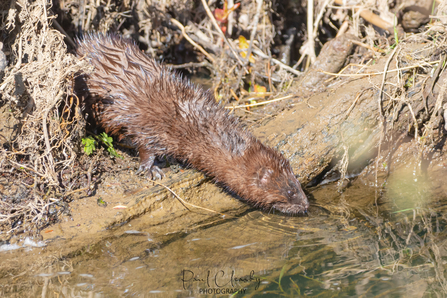
Mink Deerness, image by Paul Cleasby
American mink are a recent arrival, brought to the UK in the 1920’s to be farmed for their fur, they are now widespread and have had a severe negative impact on native wildlife, in particular water voles but they could also impact European polecat populations. More on that later. Although similar in their habits to polecats and ferrets, they are more aquatic and generally have uniform dark brown fur which can appear black when wet. They lack the distinctive facial markings of polecats and some ferrets, with just a small white patch on the chin or throat of some individuals. In general, they are relatively easy to tell apart from polecats and ferrets. However, there is some variety in fur colour, with much lighter grey or silver individuals making up a small percentage of the population.
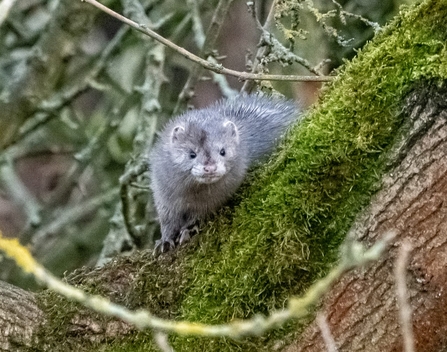
Silver mink, image by Roger Simpson
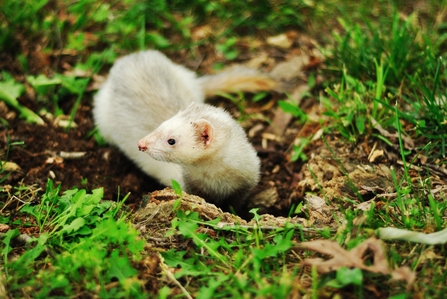
Ferret, Image by Pexels
These paler mink may have very similar colouration to ferrets, leading to possible misidentification. Although the morphology or body shape is very similar, mink are likely to have a slightly longer tail than ferrets and their fur is typically more sleek. For a more in depth look at American mink, read our blog “Introducing the American mink. Invasive species week”.
The European polecat Mustela putorias is native to the UK and most likely arrived on our shores at the end of the last ice age. It was once widespread but declined significantly during the 18th and 19th centuries, its range eventually contracting to mid-Wales and parts of Herefordshire and Shropshire, with a population of just 5000. Regarded as a pest and valued for its fur, persecution and habitat fragmentation were the main causes of this decline. However, a reduction in pressure from gamekeepers during the 20th century and legal protection under the Wildlife and Countryside Act 1981 have contributed to polecat recovery. Research by the Vincent Wildlife Trust (VWT) in 2014/15 showed that they can now be found in much of their former range in England and Wales. Here in North East England, we appear to be very much on the edge of their range, with polecats established to the West in Cumbria and a mix of polecat and polecat-ferret hybrids recorded in the eastern Yorkshire Dales. The 2015 study had one verified polecat record from South Northumberland along with a several polecat-ferrets. No verifiable records were received from North Northumberland, Durham or North-east Yorkshire but if their range expansion continues, we can expect these areas to be recolonised soon enough.
One barrier to polecat expansion from Cumbria into our region may be continued trapping pressure in areas such as the North Pennines, where traps are routinely set to control predators of grouse and other upland birds. While schedule 6 of the Wildlife and Countryside Act 1981, makes it an offence to deliberately set traps specifically for polecats without a licence, evidence suggests they are inadvertently killed or injured in traps legally set for other species. Ironically it is this same trapping effort by gamekeepers, which has helped to keep populations of the invasive American mink low in the Uplands, thus allowing water vole populations to continue to persist while they have declined rapidly elsewhere.
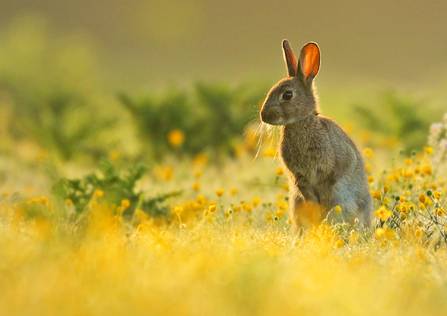
Rabbit, Image by Jon Hawkins
The status of the rabbit population may also have a significant impact, as they are known to be the main source of prey in the UK. The British Trust for Ornithology Breeding Bird Survey 2019 reports a 64% decline in the rabbit population across the UK from 1996-2018 and a 68% decline in North East England. Although polecats are an adaptable predator and have been shown to shift their diet to other prey in the absence of rabbits, a significant decline in their main prey may still have an impact, especially where alternative food sources are not abundant. Other potential barriers to polecat range expansion include secondary rodenticide poisoning, where polecats feed on poisoned rats.
Elsewhere in Europe polecat populations are not fairing so well, with several countries reporting declines, most likely as a result of habitat loss and degradation, with drainage of wetlands cited as a particular problem. However, direct competition with American mink may also be a threat to polecat populations across their entire range.
A recent study showed a connection between the presence of invasive American mink and a shift in the adult sex ratio of native European polecat, with fewer females recorded. This pattern was observed across the entire polecat range and it is thought that the large, dominant mink are responsible for higher rates of female polecat mortality, through direct killing and competition for resources. Male polecat numbers are not similarly affected but the reduction in breeding females could disrupt breeding and hinder polecat recovery. Competition does of course go both ways and it would be interesting to know what impact the recovery of polecats in the UK could have on mink...
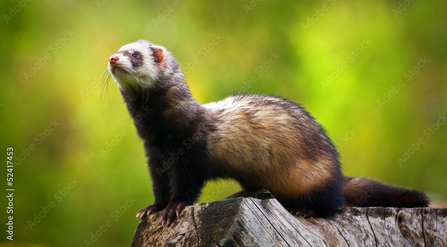
Insert ferret, Image by Adobe
Then there is the issue of hybridisation between polecats and ferrets. Ferrets Mustela putorius fero are the only truly domesticated mustelid and are descended from European polecats. Not much is known about the history of their domestication but it is thought to have occurred around 2500 years ago for the purpose of hunting rabbits and rodents. To this day they are still used for hunting, being released down burrows to bolt rabbits into nets. Inevitably some individuals are lost, escape or are released, resulting in feral ferrets living in the wild. As ferrets and polecats are extremely closely related, they are able to interbreed and produce viable young. Hybridisation is most likely to occur on the edge of the polecats range and this is supported by three separate distribution surveys by VWT, where the proportion of polecat-ferret type individuals was highest away from the core polecat range.
So, if they interbreed, is it possible to tell a true polecat, ferret and a polecat-ferret apart and does it even matter?
The short answer to the first question is yes but it's not perhaps as easy as we once thought.
There are some characteristic differences between the pelage or fur patterns and colouration of true polecats and polecat-ferrets. Typically, true polecats have a well-defined white face mask, with dark fur reaching its nose and a darker pelage overall. On the other hand, polecat-ferrets tend to be lighter, with more extensive pale face markings and may often have a pale throat patch and white fur on their paws. VWT have produced a detailed guide here.
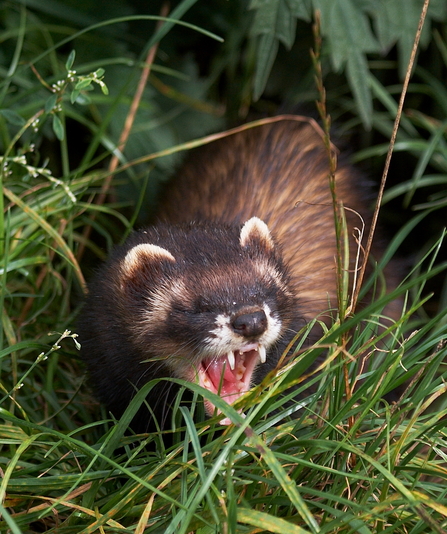
Polecat, Image by Elliot Smith
However a Cardiff University study has shown that you can’t always judge a book by its cover, or a mustelid by its pelage. Genetic analysis showed that some individuals that looked like true polecats had ferret ancestry, while others with apparently ferrety traits did not.
This ambiguity makes it challenging to for those trying to record their “polecat” sighting accurately and may lead to legal confusion, as trapping ferrets and of course American mink is legal, but intentionally setting a trap for a polecat without a license is not. With that in mind, the pragmatic approach may well be that if it looks like a polecat, treat it like a polecat. Evidence also suggests that polecat characteristics are likely to be dominant over ferrety ones and over time the population will revert to polecat type, in spite of some hybridisation. That is not to say we shouldn’t aim to reduce the likelihood of hybridisation occurring and efforts should be made to reduce the number of ferrets escaping into the wild.
There is much to be learnt from these diminutive predators, such as the catastrophic impact the introduction of a non-native predators can have on native flora. While ferrets have not impacted species on mainland Britian to nearly the same extent as American mink, largely because they so closely fill the niche left by native polecats, elsewhere in the world in countries like New Zealand, their impact has been every bit as bad. We should not ignore the impact our domesticated friends may have when let loose.
The most important lesson I believe we can take away, is the ability for species, like the European Polecat, to recover when given space, time and the conditions they need. This of course also requires our understanding and a desire to see it happen. Provided we continue to strive for biodiversity recovery, I believe we can see more species coming back from the brink, just as polecats have done.
Please report you mink sightings to NaturallyNative@durhamwt.co.uk.
To learn more about Naturally Native visit https://www.durhamwt.com/naturally-native

